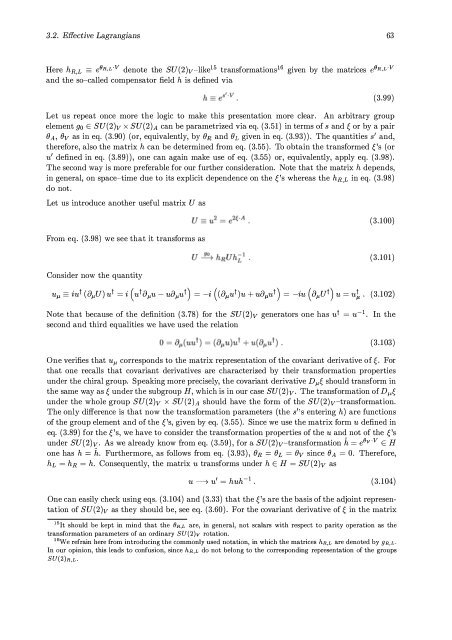The Nucleon-Nucleon Interaction in a Chiral Effective Field Theory
The Nucleon-Nucleon Interaction in a Chiral Effective Field Theory
The Nucleon-Nucleon Interaction in a Chiral Effective Field Theory
You also want an ePaper? Increase the reach of your titles
YUMPU automatically turns print PDFs into web optimized ePapers that Google loves.
3.2. Eifective Lagrangians 63<br />
Here hR,L == iJR,L'V denote the SU(2)v-like15 transformations16 given by the matrices e(}R,L'V<br />
and the so-called compensator field h is def<strong>in</strong>ed via<br />
(3.99)<br />
Let us repeat once more the logic to make this presentation more dear. An arbitrary group<br />
element go E SU(2)v X SU(2)A can be parametrized via eq. (3.51) <strong>in</strong> terms of s and � or by a pair<br />
eA, ev as <strong>in</strong> eq. (3.90) (or, equivalently, by eR and eL given <strong>in</strong> eq. (3.93)). <strong>The</strong> quantities s' and,<br />
therefore, also the matrix h can be determ<strong>in</strong>ed from eq. (3.55). To obta<strong>in</strong> the transformed fs (or<br />
u' def<strong>in</strong>ed <strong>in</strong> eq. (3.89)), one can aga<strong>in</strong> make use of eq. (3.55) or, equivalently, apply eq. (3.98).<br />
<strong>The</strong> second way is more preferable for our furt her consideration. Note that the matrix h depends,<br />
<strong>in</strong> general, on space-time due to its explicit dependence on the fs whereas the hR,L <strong>in</strong> eq. (3.98)<br />
do not.<br />
Let us <strong>in</strong>troduce another useful matrix U as<br />
From eq. (3.98) we see that it transforms as<br />
(3.100)<br />
(3.101)<br />
Consider now the quantity<br />
uJ1, == iut (8J1,U) ut = i (ut 8J1,u - u8J1,ut) = -i ((8J1,ut)u + u8ttut) = -iu (8J1,Ut) u = u1 . (3.102)<br />
Note that because of the def<strong>in</strong>ition (3.78) for the SU(2)v generators one has ut = u-1. In the<br />
second and third equalities we have used the relation<br />
(3.103)<br />
One verifies that utt corresponds to the matrix representation of the covariant derivative of �. For<br />
that one recalls that covariant derivatives are characterized by their transformation properties<br />
under the chiral group. Speak<strong>in</strong>g more precisely, the covariant derivative Dtt� should transform <strong>in</strong><br />
the same way as � under the subgroup H, which is <strong>in</strong> our case SU(2)v. <strong>The</strong> transformation of Dtt�<br />
under the whole group SU(2)v x SU(2)A should have the form of the SU(2) v-transformation.<br />
<strong>The</strong> only difference is that now the transformation parameters (the s" s enter<strong>in</strong>g h) are functions<br />
of the group element and of the fs, given by eq. (3.55). S<strong>in</strong>ce we use the matrix form u def<strong>in</strong>ed <strong>in</strong><br />
eq. (3.89) for the fs, we have to consider the transformation properties of the u and not of the fs<br />
under SU(2)v. As we already know from eq. (3.59), for a SU(2)v-transformation h = e(}v'<br />
v<br />
EH<br />
one has h = h. Furthermore, as follows from eq. (3.93), eR = eL = ev s<strong>in</strong>ce eA = O. <strong>The</strong>refore,<br />
hL = hR = h. Consequently, the matrix u transforms under h E H = SU(2)v as<br />
u ---+ u' = huh-1 • (3.104)<br />
One can easily check us<strong>in</strong>g eqs. (3.104) and (3.33) that the �'s are the basis of the adjo<strong>in</strong>t representat<br />
ion of SU(2)v as they should be, see eq. (3.60). For the covariant derivative of � <strong>in</strong> the matrix<br />
15It should be kept <strong>in</strong> m<strong>in</strong>d that the (h,L are, <strong>in</strong> general, not scalars with respect to parity operation as the<br />
transformation parameters of an ord<strong>in</strong>ary SU(2)v rotation.<br />
lßWe refra<strong>in</strong> here from <strong>in</strong>troduc<strong>in</strong>g the commonly used notation, <strong>in</strong> which the matrices hR,L are denoted by 9R,L.<br />
In our op<strong>in</strong>ion, this leads to confusion, s<strong>in</strong>ce hR,L do not belong to the correspond<strong>in</strong>g representation of the groups<br />
SU(2)R,L.












